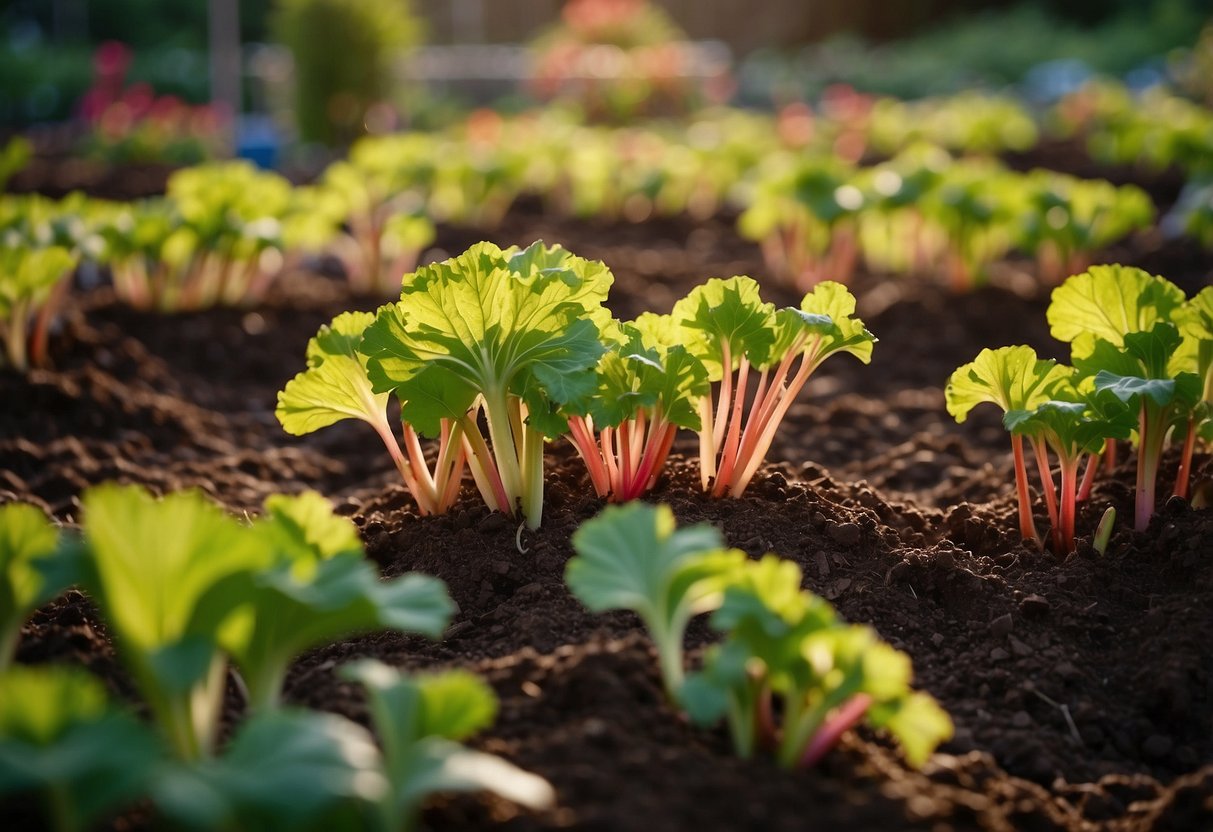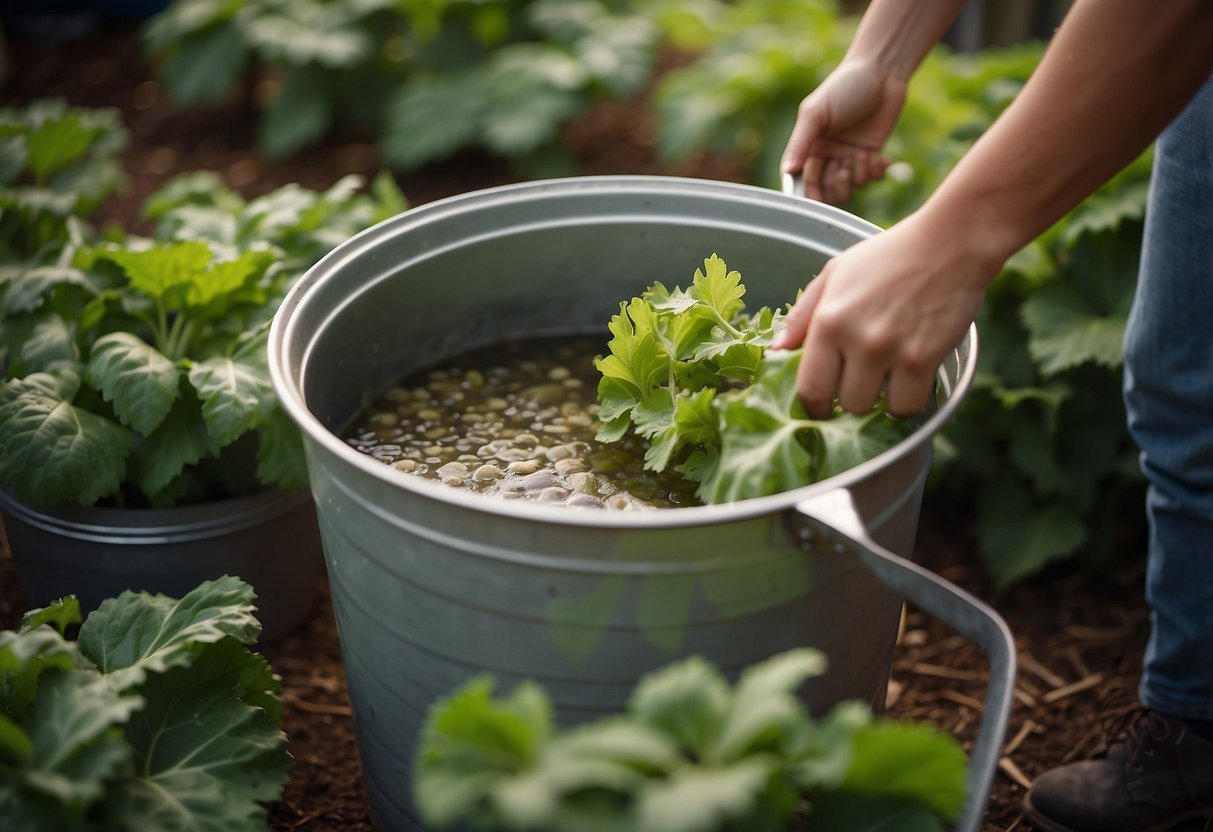Rhubarb Garden Ideas: Creative Ways to Grow and Enjoy Rhubarb
Rhubarb is a versatile and hardy plant, perfect for adding a touch of beauty and functionality to your garden. Whether you’re new to gardening or an experienced green thumb, incorporating rhubarb into your outdoor space can be a rewarding experience. Not only does it provide delicious and nutritious stalks for cooking, but it also offers striking foliage that enhances any garden setting.

You can explore various rhubarb garden ideas to make the most of this perennial plant. From designing a dedicated rhubarb patch to integrating it into your existing garden layout, the possibilities are endless. You’ll enjoy not just the culinary benefits, but also the aesthetic appeal that rhubarb brings to your outdoor oasis.
1) Raised Bed Rhubarb Garden

Using a raised bed for your rhubarb garden is a great idea. It helps you control soil conditions. Rhubarb loves slightly acidic soil with a pH of 5.5 to 6.5.
Mix garden soil, compost, and aged manure in equal parts. This creates a nutrient-rich mix perfect for rhubarb. Start planting in early spring.
Give rhubarb plants room to grow by spacing them 3 feet apart. Ensure the raised bed is well-drained for the best results.
2) Compost-Enriched Soil

Using compost in your rhubarb garden can do wonders. It’s full of nutrients that plants love. Rhubarb leaves, despite containing oxalic acid, can be safely composted. The composting process breaks down this acid.
Compost improves soil structure and keeps it healthy by promoting beneficial microorganisms. Adding composted rhubarb leaves boosts nitrogen, potassium, and phosphorus levels. This helps your rhubarb thrive.
Ensure your compost pile reaches a temperature between 120°F and 160°F to keep it effective. This makes your garden more productive and vibrant.
3) Mulching Tips

Mulching helps your rhubarb grow healthy and strong. Use cedar mulch to keep the soil moist and prevent weeds. It’s a long-lasting option throughout the year.
Consider using Scotts Growing Media Mulch, which is great for rhubarb and other vegetables. Apply a 3-inch layer after your rhubarb seeds have germinated.
Make sure to choose organic mulches if you prefer natural materials.
4) Rhubarb Variety Selection

Choosing the right rhubarb variety for your garden can make a big difference. One popular choice is Strawberry Rhubarb with its vibrant red color and sweet-tart flavor. It’s great for pies and jams.
If you want something unique, try Noble Rhubarb, known for its translucent leaves. For high yields, consider Grandad’s Favorite. Don’t forget to match the variety with your climate to ensure a healthy and productive garden!
5) DIY Rhubarb Fertilizer

Creating your own rhubarb fertilizer at home is simple and rewarding. You can use coffee grounds to boost your rhubarb. Spread the leftover coffee grounds around each plant.
Mix a tablespoon of Epsom salt in a gallon of water and pour it over the coffee grounds. This mixture helps lower soil pH and adds magnesium, which rhubarb needs to grow well.
For an additional boost, throw some well-aged compost around your plants in early spring. This adds nutrients and helps your rhubarb thrive.
6) Pest Control Methods

If you notice flea beetles munching on your rhubarb, you can use diatomite or pesticides from the garden center to get rid of them.
To deter stem borers, try using neem oil, diatomite, or insecticidal soap.
Rhubarb curculio can be identified by the notches on leaf edges and wilting stems.
For potato stem borers, consider setting up traps or using organic insecticides.
Encouraging beneficial insects like ladybugs can help manage pests naturally.
Using homemade insecticidal soap spray is another effective organic method for keeping pests at bay.
Remember to always shield your rhubarb from contact sprays to protect your crop.
7) Companion Planting Strategies

Companion planting can boost your rhubarb’s growth and keep pests away. Planting dill nearby can help disintegrate heavy soils, making it easier for rhubarb roots to spread. Dill also attracts pollinators and repels aphids.
Consider adding catnip, which is great for repelling fleas, beetles, and weevils. You can learn more about these suggestions here and here.
Turnips and beans are also useful companion plants. They provide nutrients to the soil and help your rhubarb grow strong.
8) Watering Schedule

Watering rhubarb is pretty simple once you get the hang of it. You should give your plants about 1-1.5 gallons of water each time you water them. Remember to water at the base to avoid wetting the leaves and stems.
Try to keep the soil consistently moist, but not soggy. Too much or too little water can harm your rhubarb. Checking the soil moisture regularly is a good habit. For established plants, about one inch of water per week, including rainfall, is ideal. Mulching around your plants can also help retain moisture in the soil.
9) Harvesting Techniques

When it’s time to harvest your rhubarb, you should gently grasp the stalk near the base.
Use a firm, twisting motion to pull the stalk free. This method promotes healthier plants and future growth.
For safety, remember to discard the leaves as they contain oxalic acid.
10) Winterizing Your Rhubarb Garden

To prepare your rhubarb for winter, start by removing any debris around the plants. This helps to reduce the chance of pests and diseases.
Mulch the base of your rhubarb plants with straw or leaves. This keeps the roots insulated from the cold.
Once a hard frost kills the stalks, cut them back and add another layer of mulch. This helps the plants stay healthy through the winter months.
Planning Your Rhubarb Garden

To have a successful rhubarb garden, you need to choose the best spot and prepare the soil properly. This section will guide you through these essential steps.
Choosing the Right Spot
Rhubarb thrives in sunny areas. Find a spot in your garden that gets at least six hours of sunlight each day. Avoid shady areas, as rhubarb needs sunlight to grow strong and healthy.
Space is important. Plant rhubarb where it has enough room to spread out. Each plant should be placed about 3 feet apart. This spacing helps the plants grow without competing for nutrients.
Rhubarb prefers well-drained soil. If your garden has heavy clay soil, consider planting rhubarb in raised beds to improve drainage. Good air circulation around the plants can also help prevent diseases.
Soil Preparation
Preparing the soil is key to a healthy rhubarb garden. Start by loosening the soil to a depth of about 12 inches. This helps the roots grow deep and strong. Remove any weeds or rocks that can impede growth.
Add organic matter like well-rotted manure or compost. Mix it into the soil to improve its texture and fertility. This gives rhubarb the nutrients it needs. For best results, do this either in the fall or early spring.
Rhubarb crowns should be planted so that the tip is about 1 inch below the soil surface. For areas with heavier, wetter soil, ensure the rhubarb crown rests at ground level. This prevents the crown from rotting in waterlogged soil.
Planting Rhubarb

Planting rhubarb can be straightforward if you follow a few crucial steps. It’s important to plant at the right time and ensure there’s enough space for the plants to grow.
When to Plant
Plant rhubarb crowns in early spring as soon as the soil is workable. This gives the plants a full growing season to establish themselves. Another option is to plant in autumn, after the summer heat has gone, which allows the crowns to settle before the next growing season.
Using well-rotted manure or compost is key. This enriches the soil and gives rhubarb the nutrients it needs. Avoid planting in wet, heavy soil because it can cause roots to rot. If you have heavy soil, consider planting on raised beds or mounds to improve drainage.
Spacing Rhubarb Plants
Rhubarb plants need plenty of room to grow. Space them about 36 inches apart in rows that are 3 to 4 feet apart. This spacing allows sufficient airflow and light, which helps prevent disease and promotes strong growth.
When planting, dig holes that are large enough to accommodate the root system. Place the crowns so the buds are pointing up and about 1 to 2 inches below the soil surface. Firm the soil gently around the crowns and water well.
By following these guidelines, your rhubarb plants should thrive and produce for many years.
Caring for Rhubarb Plants

To keep your rhubarb plants healthy and productive, focus on watering them properly, fertilizing them right, and protecting them from pests.
Watering Needs
Rhubarb plants need consistent moisture, especially during dry periods. When watering, aim for the soil to be damp but not waterlogged. Overwatering can cause root rot, while under-watering can lead to tough, fibrous stalks.
Water deeply once a week, ensuring the water reaches at least six inches into the soil. During very hot or dry periods, increase watering to twice a week. Mulching around the plants can help retain soil moisture and keep roots cool. Avoid watering the leaves directly to prevent mold and disease.
Fertilizing Tips
Rhubarb thrives with regular feeding. In early spring, before new growth appears, apply a balanced fertilizer like a 10-10-10 mix. Work the fertilizer into the top few inches of soil around each plant.
Mid-season, you can give your plants a boost with a side dressing of compost or aged manure. Avoid over-fertilizing, as too much nitrogen can lead to lots of leaves but small stalks. Make sure to water the plants well after fertilizing to help nutrients reach the roots.
Pest Control
Rhubarb usually has few pests, but watch out for aphids and rhubarb curculio. Aphids can weaken plants by sucking sap, while rhubarb curculio is a beetle that bores into stalks.
To combat aphids, use a strong spray of water to knock them off or apply insecticidal soap. For rhubarb curculio, hand-pick the beetles and destroy any infested stalks. Keeping your garden clean and removing plant debris can also help minimize pest problems. Regularly inspect your plants for signs of pest damage to catch issues early.
Taking these steps will help ensure your rhubarb plants remain healthy and produce delicious stalks year after year.







